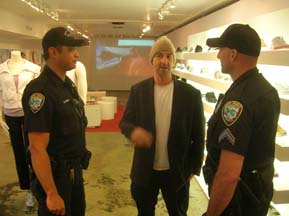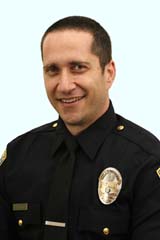|
By Jorge Casuso
April 15 -- It was a Friday evening, and darkness had
just fallen on the Third Street Promenade. For police officers Steve
Perez and Koby Arnold, it had been a typical day patrolling one
of the nation’s busiest outdoor shopping strips.
They had cruised the surrounding streets in their squad car and
walked the three-block-long beat, issuing a half dozen citations
and as many warnings and dropping in on merchants to touch base.
“There’s been a lot of people out here, but it hasn’t
been too busy,” said Perez, who’s in charge of the Third
Street bicycle unit.
Then, just before their shift ended at 8 p.m., a group of young
men strolled by.
 (Officers
Steve Perez and Koby Arnold check in on a Promenade merchant) (Officers
Steve Perez and Koby Arnold check in on a Promenade merchant) |
“That guy’s crazy,”
one of the men told the officers.
“The guy following us is crazy,” another repeated
as he passed by.
Perez and Arnold went into action. They quickly spotted the
homeless man in question stumbling among the growing crowd,
put on rubber gloves and handcuffed him. The elderly black
man could barely stand. He was slurring, incoherent. |
“We’re citing him for being intoxicated in public,”
Perez said. “He’s a chronic inebriate. Sometimes, he
becomes violent. He can’t care for his safety or the safety
of others.”
The man, whose name is Frank, was escorted to a squad car the officers
had summoned and driven to jail, where he would spend the rest of
the weekend until a court date Monday, when the City would seek
a restraining order barring him from the Promenade area.
Perez and Arnold are part of a team of four sworn officers who patrol
the area bordered by the alley east of Ocean Avenue, the alley between
4th and 5th streets, Wilshire Boulevard and Broadway.
Another eight officers cover the larger Downtown area bounded by
Palisades Park, Lincoln Avenue, California Avenue and the 10 Freeway.
The two Downtown details are backed by ten community service officers,
who can’t carry guns or make arrests.
The officers are part of a new neighborhood policing plan instituted
by Police Chief Tim Jackman that boosts the number of sworn officers
patrolling the Bayside District from eight to 12 and helps put a
face on those who cover the beat, often on foot and bicycles.
The officers are assigned to at least six consecutive months, assuring
they will become a familiar face on the street – getting to
know the merchants and their needs and concerns and building bridges
with homeless service providers and those, like Frank, they try
to help.
“They really get to know all the ins and outs of what’s
going on,” said Sgt. Ken Semko, who is in charge of Downtown
patrols.
| “We can build relationships
with everybody,” said Jeffrey Glaser, who as the area’s
Neighborhood Resources Officer serves as the “quarterback”
who coordinates the efforts needed to address a problem. “Everybody
is going to get to know everybody, like a small town sheriff.”
From a hive of bees nesting in the rafters of a Promenade
building to a frightened worker walking to a parking structure
during a power blackout, the beat officers say they are there
to call Vector Control or escort motorists to their cars.
Jeffrey Glaser |
 |
They’re also there to serve as a liaison for residents and
businesses, helping connect them to the proper service no matter
how small the problem may seem.
“Nothing is too insignificant to report,” said Semko,
who began patrolling the area as a rookie cop in 1991. “Anything
law enforcement can help with, we’ll help – from maintenance
issues to noise, we can steer them to the services they need.
“We tell merchants and residents, ‘If you see something
going on, call us,’” he added. “People will say,
‘I’m having a problem with a tree. The leaves are falling
off.’ We get beehive calls. We’re really an information
source.”
When not busy providing answers to problems, the beat officers are
out enforcing a myriad of Santa Monica laws – from noise levels
for street performers to the City’s smoking ban. Friday was
a typical day on the beat.
In addition to arresting Frank for being drunk in public, Perez
and Arnold cited a homeless man for drinking and littering in Palisades
Park, another for sitting on the sidewalk and smoking and a third
for digging recyclables out of a bin. (The last two were repeat
offenders.)
And it wasn’t only the homeless who kept the officers busy.
They caught a teenager who had shoplifted clothing, glasses and
a key chain from two Promenade stores, recovered the goods and turned
her over to her mother. (Police said shoplifting on the Promenade
seems to be on the rise since Santa Monica Place shut down for a
major remodel.)
They also caught a motorist illegally occupying a handicap space.
(The man worked on the Promenade and was bringing friends to spend
the evening on the strip).
And they responded to a call from an “airship” that
a suspicious person was photographing buildings from the top of
a parking structure. (The man, who was shooting panoramic views
of the city, was advised to leave.)
The officers also issued numerous warnings. They stopped a Japanese
tourist with dreadlocks from pulling a cigarette from his pack and
lighting up, informing him that smoking was banned on the Promenade
and directing him to the designated smoking zone.
In addition, they stopped two kids who zoomed by on razor scooters
in defiance of a city ordinance banning skating and bicycling on
the crowded Promenade.
These are the kinds of warnings that can be issued by a team of
ambassadors the Bayside District would hire if a new assessment
plan is approved by merchants, said Capt. Wendell Shirley, who as
head of the Office of Operations is in charge.
The $1.2-million-a-year program would put uniformed ambassadors
on the streets and in public restrooms 15 hours a day, seven days
a week to provide a “concierge” service for visitors
and “assist police to discourage nuisance crimes,” according
to the plan.
“We support the program,” said Shirley. “It gives
us an extra pair of eyes and ears out there helping to report issues
. . . They would have no more power than a regular citizen would
have, but they can inform (the public) about the laws.”
The department has offered to train the ambassadors, who would not
use police radios, but would route their calls, like the public
does, through police dispatch, Shirley said. Like the beat officers,
the ambassadors would become familiar faces.
“When they know a name and a face,” he said, “it
goes a long way towards working together.”
The neighborhood policing plan has been working, the beat officers
said. Take the homeless problem that has consistently topped the
list of concerns in resident and merchant polls alike.
By being there day in and day out and connecting directly with merchants
and homeless agencies, police have made progress addressing the
problem, Semko said.
“The cooperation with a lot of businesses Downtown is helping
with tools that enable us to enforce laws and get (the homeless)
into services,” Semko said. “It’s not an overnight
solution, but we’re starting to see some tangible results
we haven’t gotten in the past.
“We’re getting cooperation with all the parties involved,”
he said. “We’re starting to meld together. We sat around
the table and realized we had a common goal.”
The beat officers have also reached out to the homeless. “The
people we commonly run into, our folks know very well,” Semko
said. “We know them by name. We know the things they’re
going through.”
The officers have learned the social patterns of the homeless and
realized that they often congregate around those who have been living
on the streets the longest.
“The word transient is kind of funny,” said Semko. “Transients
get very territorial. They like the same spot. They know the others
out there, the law enforcement, where they need to go to take care
of themselves.”
The City’s efforts to target and house the “chronic
homeless” who have been on the streets the longest and are
most at risk of dying is working, police said.
“In the last few months, we’ve had people that have
been out here for ten years that you don’t see anymore,”
Semko said. “When people out here for years start to disappear
(from the streets), a lot of people will leave as well. It’s
a domino effect.”
Perez added, “When you see somebody being successful with
a program, they think they can get help as well.”
The officers also have worked directly with business and property
owners to enforce an ordinance that bans sleeping in Downtown doorways.
The owners must file no-trespassing letters every month giving police
the go-ahead to enforce the law.
“The vast majority is cooperating,” Semko said. “It’s
something that’s helping everybody, not just the businesses.”
Soon, the new officers will begin enforcing an ordinance approved
by the City Council on first reading that bans panhandling from
Promenade benches.
“The homeless use the benches as a place of operation,”
said Glaser. “It’s a problem because of the limited
seating.”
With as many as 10,000 visitors streaming through each block of
the Promenade every hour on busy nights, Semko and his team keep
busy. But it’s a beat he wouldn’t trade.
“I love interacting with people in the area,” Semko
said. “You get a sense of pride in your area. You have an
emotional tie to the area you work in.”
|